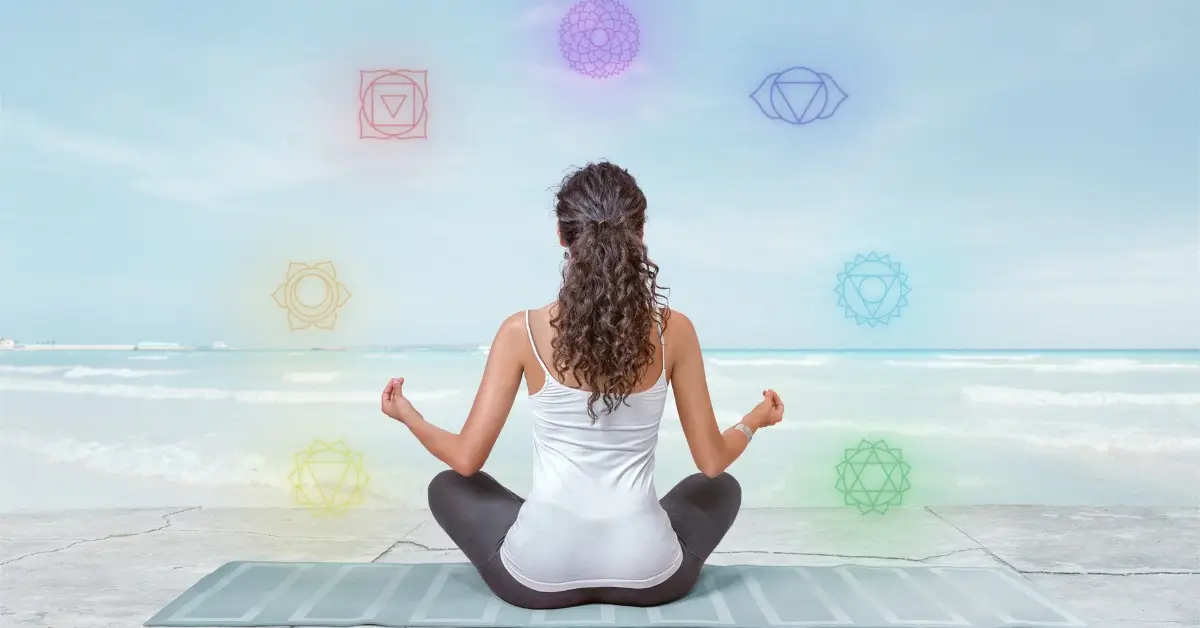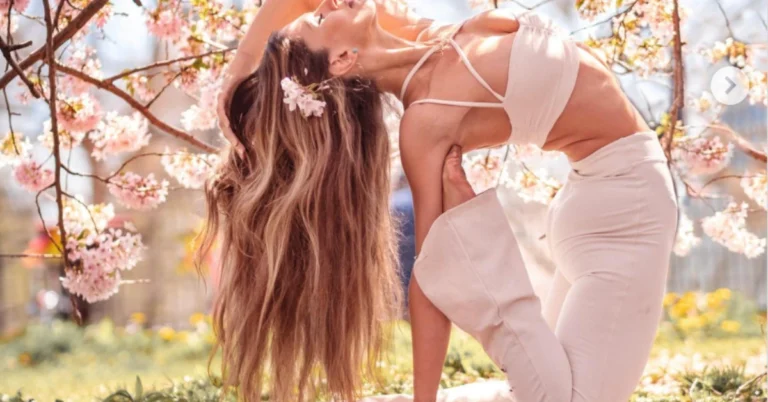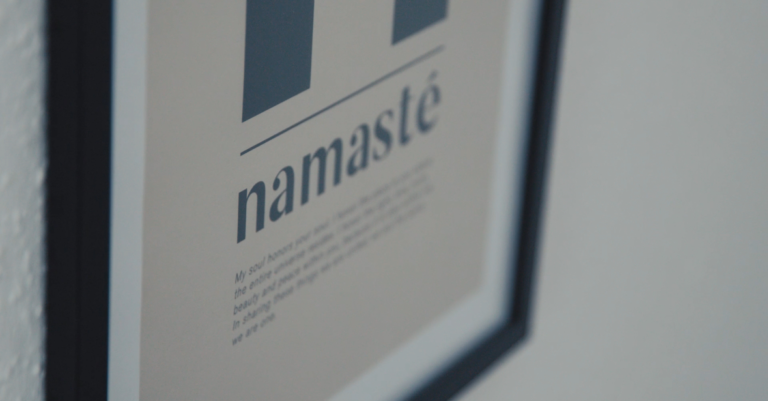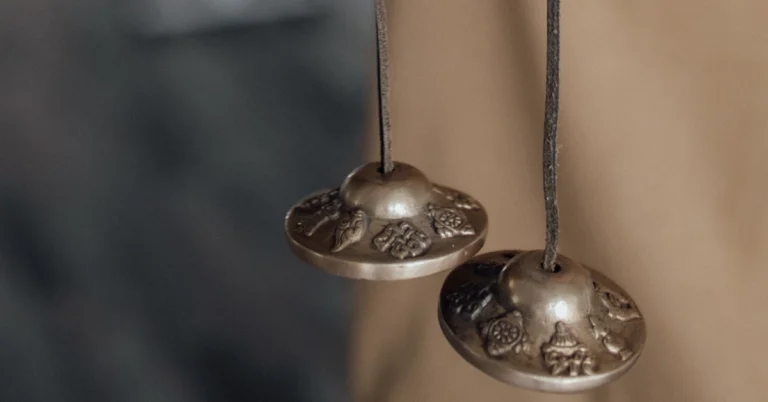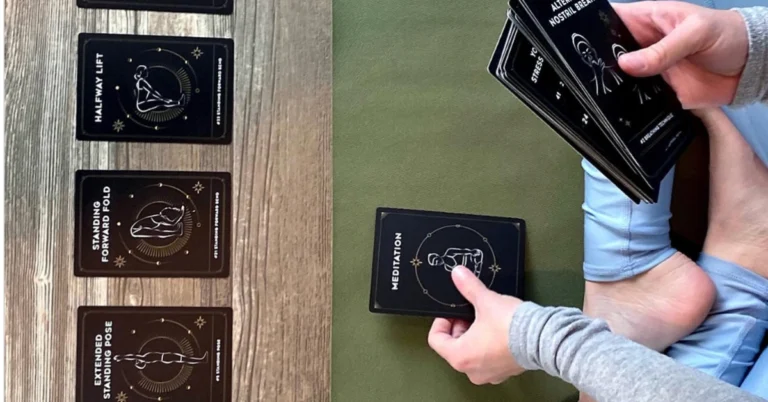Color chakra meditation is a form of meditation that involves focusing on the colors associated with the seven chakras of the body. Each chakra is associated with a specific color, and by meditating on these colors, one can balance the energy flow in their body. The seven chakras and their corresponding colors are the root chakra (red), sacral chakra (orange), solar plexus chakra (yellow), heart chakra (green), throat chakra (blue), third eye chakra (indigo), and crown chakra (violet/white).
During a color chakra meditation, one can visualize each chakra and its corresponding color, starting from the root chakra and moving up to the crown chakra. By focusing on each chakra and its color, one can bring balance to their energy centers and promote healing and peace of mind. This form of meditation is believed to be a simple yet powerful way to balance the chakras and promote overall well-being.
I love this Yoga mat 🧘🏼♀️
✅ Anti-Slip Surface ✅ Effortless Cleaning
✅ Conscious & Safe Materials
Understanding Color Chakras
Color chakras are the energy centers in our bodies that correspond to different colors and vibrations. There are seven chakras in total, each with its own unique color and significance. Understanding the color chakras can help you to better understand yourself, your emotions, and your physical health.
Here is a brief overview of each of the seven color chakras:
1. Root Chakra (Muladhara)
The root chakra is located at the base of the spine and is associated with the color red. It represents our foundation and grounding, as well as our sense of safety and security. When this chakra is balanced, we feel grounded and secure in our lives.
2. Sacral Chakra (Swadisthana)
The sacral chakra is located in the lower abdomen and is associated with the color orange. It represents our creativity, sexuality, and emotions. When this chakra is balanced, we feel creative, passionate, and emotionally stable.
3. Solar Plexus Chakra (Manipura)
The solar plexus chakra is located in the upper abdomen and is associated with the color yellow. It represents our personal power, self-esteem, and willpower. When this chakra is balanced, we feel confident, motivated, and in control of our lives.
4. Heart Chakra (Anahata)
The heart chakra is located in the center of the chest and is associated with the color green. It represents our ability to love and connect with others, as well as our emotional balance. When this chakra is balanced, we feel open, compassionate, and able to give and receive love.
5. Throat Chakra (Vishuddha)
The throat chakra is located in the throat and is associated with the color blue. It represents our ability to communicate and express ourselves, as well as our creativity. When this chakra is balanced, we feel confident in our ability to speak our truth and express ourselves creatively.
6. Third Eye Chakra (Ajna)
The third eye chakra is located in the center of the forehead and is associated with the color indigo. It represents our intuition, wisdom, and spiritual insight. When this chakra is balanced, we feel connected to our inner guidance and able to trust our intuition.
7. Crown Chakra (Sahasrara)
The crown chakra is located at the top of the head and is associated with the color violet or white. It represents our connection to the divine and our spiritual consciousness. When this chakra is balanced, we feel a sense of oneness with all that is and a deep understanding of our place in the universe.
By understanding the color chakras and their significance, we can work to balance and align our energy centers, leading to greater physical, emotional, and spiritual well-being.
Basics of Color Chakra Meditation

Meditation is a practice that has been around for centuries. It involves training the mind to focus and achieve a state of calm and relaxation. Meditation can be done in many different ways, including through the use of color chakra meditation.
To begin meditating, find a quiet and comfortable place where you can sit or lie down. Close your eyes and take a few deep breaths, focusing on your breathing and letting go of any thoughts or distractions.
Once you feel relaxed and centered, you can begin to focus on the colors associated with each chakra. There are seven chakras in the body, each with its own color and energy. They are:
| Chakra | Color |
|---|---|
| Root | Red |
| Sacral | Orange |
| Solar Plexus | Yellow |
| Heart | Green |
| Throat | Blue |
| Third Eye | Indigo |
| Crown | Violet/White |

To meditate on a specific chakra, visualize the corresponding color and focus on it. You can also use guided meditations or affirmations to help you connect with each chakra.
It’s important to remember that meditation is a practice, and it may take time to develop your skills and find what works best for you. Don’t get discouraged if you find it difficult at first – with practice and patience, you can achieve a state of calm and relaxation through color chakra meditation.
Color Chakra Meditation Techniques

As I practice chakra color meditation, I find it helpful to use different techniques to enhance my experience. Here are a few techniques I use:
Breathing Techniques
One technique I use during chakra color meditation is to focus on my breath. I breathe deeply and consciously, inhaling and exhaling slowly. As I inhale, I imagine that I am breathing in the color associated with the chakra I am focusing on. For example, if I am focusing on the root chakra, I imagine that I am breathing in the color red. As I exhale, I visualize any tension or negative energy leaving my body. This technique helps me to feel more relaxed and centered.
Visualization Techniques
Another technique I use during chakra color meditation is visualization. I visualize the color associated with the chakra I am focusing on, surrounding me and filling my body. For example, if I am focusing on the heart chakra, I visualize a green light surrounding me and filling my heart center. I also visualize any blockages or negative energy being released and replaced with positive energy. This technique helps me to feel more connected to my chakras and to the energy around me.
In conclusion, there are many techniques that can be used during chakra color meditation to enhance the experience. By using breathing and visualization techniques, I am able to focus more deeply on my chakras and to feel more connected to my body and the world around me.
Benefits of Color Chakra Meditation

Color chakra meditation is a powerful technique for balancing the energy centers in the body. Here are some of the benefits of practicing color chakra meditation:
1. Promotes relaxation and reduces stress
Color chakra meditation helps to calm the mind and promote relaxation. By focusing on the different colors associated with each chakra, you can release tension and reduce stress. This can be especially helpful for individuals who suffer from anxiety or have a hard time relaxing.
2. Enhances overall well-being
Color chakra meditation can enhance your overall well-being by promoting physical, mental, and emotional health. By balancing the energy centers in your body, you may experience improved digestion, better sleep, increased focus, and a greater sense of inner peace.
3. Boosts creativity and intuition
Color chakra meditation can help to unlock your creative potential and enhance your intuition. By focusing on the colors associated with each chakra, you can tap into your inner wisdom and connect with your higher self. This can be especially helpful for artists, writers, and other creative individuals.
4. Improves physical health
Color chakra meditation can also have a positive impact on your physical health. By balancing the energy centers in your body, you may experience improved circulation, reduced inflammation, and a stronger immune system. This can help to prevent illness and promote overall health and well-being.
5. Enhances spiritual growth
Color chakra meditation can help you to connect with your spiritual self and enhance your spiritual growth. By focusing on the different colors associated with each chakra, you can open yourself up to new levels of awareness and understanding. This can help you to live a more fulfilling and meaningful life.
Common Challenges and Solutions In Color Chakra Meditation

Distraction
One of the most common challenges in color chakra meditation is distraction. It is normal for the mind to wander during meditation, especially if you are new to it. However, it can be frustrating and discouraging. Here are some tips to help you stay focused during meditation:
- Set an intention: Before you start your meditation, set an intention for what you want to achieve. This can help you stay focused and motivated.
- Focus on your breath: Whenever you notice your mind wandering, bring your attention back to your breath. Focus on the sensation of the air moving in and out of your body.
- Use a mantra: A mantra is a word or phrase that you repeat to yourself during meditation. It can help you stay focused and calm.
Physical Discomfort
Another challenge in color chakra meditation is physical discomfort. Sitting still for an extended period can be uncomfortable, especially if you have back pain or other physical issues. Here are some solutions to help you overcome physical discomfort during meditation:
- Use props: If you have back pain or other physical issues, use props such as cushions or blankets to support your body and make it more comfortable.
- Change your position: If you are uncomfortable in one position, try another. You can sit cross-legged, kneel, or even lie down.
- Stretch before and after: Stretching before and after meditation can help alleviate physical discomfort and prevent muscle stiffness.
Remember, meditation is a practice. It takes time and patience to master. Don’t get discouraged if you face challenges along the way. With practice and perseverance, you can overcome them and reap the benefits of color chakra meditation.
Maintaining Consistency in Chakra Color Meditation Practice

Consistency is key when it comes to chakra meditation. To reap the full benefits of this practice, it is important to maintain a regular routine. Here are some tips to help you stay consistent in your chakra meditation practice:
- Designate a specific time and place for meditation: Choose a time of day when you can meditate without interruption. Find a quiet place where you can sit comfortably and focus on your practice.
- Set a meditation goal: Determine what you hope to achieve through meditation. Whether it’s to reduce stress, improve focus, or balance your chakras, having a goal can help you stay motivated and focused.
- Start with short sessions: If you’re new to meditation, start with short sessions and gradually increase the time as you become more comfortable. Even just a few minutes of meditation each day can have a positive impact on your well-being.
- Use guided meditations: If you’re having trouble staying focused during meditation, consider using guided meditations. These can help you stay on track and provide guidance as you work on balancing your chakras.
- Track your progress: Keep a journal of your meditation practice and track your progress over time. This can help you stay motivated and see the benefits of your practice.
By following these tips, you can maintain consistency in your chakra meditation practice and reap the full benefits of this powerful healing technique. Remember, consistency is key, so make sure to prioritize your meditation practice and make it a regular part of your daily routine.
Advanced Color Chakra Meditation Techniques

As I have explored the world of color chakra meditation, I have discovered various advanced techniques that can take your meditation practice to the next level. Here are some of these techniques:
1. Chakra-Specific Color Meditation
In this technique, you focus on one chakra at a time, using the color associated with that chakra. For example, if you want to focus on your heart chakra, you would visualize the color green. You can use this technique to balance and heal specific chakras.
2. Rainbow Color Meditation
In this technique, you visualize all the colors of the rainbow, starting from red and ending with violet. You can use this technique to balance and harmonize all your chakras.
3. Candle Gazing Meditation
In this technique, you light a candle and focus on the flame while visualizing the color associated with the chakra you want to balance. For example, if you want to balance your root chakra, you would visualize the color red while gazing at the flame.
4. Sound and Color Meditation
In this technique, you use sound and color together to balance and heal your chakras. You can use singing bowls or other musical instruments that produce specific frequencies that correspond to each chakra. You can also visualize the color associated with each chakra while listening to the sound.
5. Affirmation and Color Meditation
In this technique, you use affirmations and color together to balance and heal your chakras. You can use positive affirmations that correspond to each chakra while visualizing the color associated with that chakra. For example, if you want to balance your throat chakra, you can use the affirmation “I express myself freely and confidently” while visualizing the color blue.
These advanced color chakra meditation techniques can help you deepen your meditation practice and achieve greater balance and harmony in your life.
How Can I Use Color Chakra Meditation?

Color chakra meditation is a powerful tool for achieving inner peace and relaxation. By meditating on the colors of the seven chakras, we can help balance and align the body’s energy centers, promoting physical, emotional, and spiritual well-being. It can also help reduce stress, increase mindfulness, and enhance creativity.
During color chakra meditation, it is important to focus on one color at a time and visualize it in your mind’s eye. You can also use guided meditations or music specifically designed for chakra meditation to enhance the experience.
Here are some key facts:
- Each chakra is associated with a specific color, and meditating on these colors can help balance and align the body’s energy centers.
- Red is associated with the root chakra, orange with the sacral chakra, yellow with the solar plexus chakra, green with the heart chakra, blue with the throat chakra, indigo/purple with the third eye chakra, and violet/white with the crown chakra.
- Color chakra meditation can help reduce stress, increase mindfulness, and enhance creativity.
- It is important to focus on one color at a time and visualize it in your mind’s eye during meditation.
Have fun exploring your magic color chakra meditation journey 🌈.
FAQ
What is color chakra meditation, and how does it differ from traditional chakra meditation?
Color chakra meditation is a variation of traditional chakra meditation that involves focusing on the colors associated with each chakra. Unlike the traditional approach that emphasizes energy centers, color chakra meditation places more emphasis on visualizing and working with the specific colors to balance and align the chakras.
How can color chakra meditation benefit me?
Color chakra meditation can promote balance, harmony, and well-being by using the healing properties of colors to address imbalances within the chakras. It can help enhance mood, stimulate creativity, and encourage self-awareness and self-healing by visualizing and working with colors that resonate with each chakra.
Can I practice color chakra meditation if I’m new to meditation or unfamiliar with chakras?
Yes, absolutely. Color chakra meditation can be accessible to beginners. It provides a unique and visually engaging way to explore chakras and their corresponding colors. Guided sessions are available to help newcomers understand the concepts and techniques involved.
Are there specific guidelines for using colors in chakra meditation, or is it open to personal interpretation?
Color chakra meditation can be both structured and open to personal interpretation. While there are traditional correspondences between colors and chakras, you can also explore what each color represents to you personally. It’s a practice that can be adapted to suit your individual preferences and intentions.
After exploring the serene depths of Color Chakra Meditation, we’d love to hear your thoughts and experiences. Share your insights with us in the comments below!

